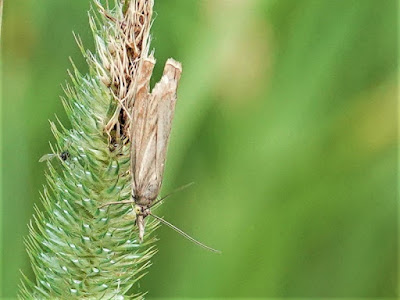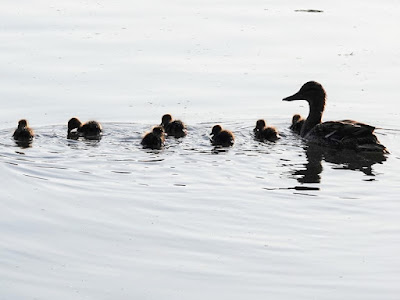10.0°C > 16.0°C: A clear start. An area of cloud to the south made some progress and arrived overhead c.08:15, tending to break as it did so with some sunny spells continuing. A lighter south-westerly breeze. Very good visibility.
Sunrise: 04:53 BST
* = a species with a photo today
+ = my first sighting of this species at this site this year.
++ = new species for me at this site.
Priorslee Balancing Lake: 05:00 – 06:20 // 07:25 – 09:45
(146th visit of the year)
Bird notes:
- A Mute Swan seen in flight overhead at 05:20 as I finished checking the street lamp pole for moths. The resident family were all together, the cob with wings raised in threat. As he was still with his cygnets I assume the visitor was dissuaded from splashing down and carried on.
- This will be the last day I split the Coot count between adults and juveniles. Some juveniles have become difficult to reliably separate from adults now.
- Just one juvenile Great Crested Grebes located. Fewer adults too.
- A second Garden Warbler was singing along the North side at c.05:50 but not later. My first on that side of the water this year.
Birds noted flying over here:
- *1 Mute Swan!
- 56 Wood Pigeons
- 1 Collared Dove
- 2 Lesser Black-backed Gulls
- 1 Jackdaw
Warblers noted (the number singing in brackets):
- 1 (1) Cetti's Warbler
- 1 (1) Willow Warbler
- 11 (11) Chiffchaffs
- 10 (9) Reed Warblers
- 7 (4) Blackcaps
- 2 (2) Garden Warblers
- 1 (1) Common Whitethroat
Hirundines etc., noted:
- c.35 Swifts
- 1 Barn Swallow
- 2 House Martins
Counts from the lake area:
- 2 + 2 Mute Swans
- 7 (?♂) Mallard
- 2 + 1 (1 brood) Moorhen
- 36 + 37 (? broods) Coots
- 6 + 1 (1 brood) Great Crested Grebes
- 4 Black-headed Gull: three adults; one first year
- 1 Grey Heron
Noted on and around the street lamp poles around dawn:
Moths:
- *1 ++Copper Ermel (Roeslerstammia erxlebella)
- *1+ Mottled Beauty (Alcis repandata)
Noted later:
Butterflies:
- *Small Skipper (Thymelicus sylvestris)
- *Large Skipper (Ochlodes sylvanus)
- Ringlet (Aphantopus hyperantus)
- Meadow Brown (Maniola jurtina)
- Comma (Polygonia c-album)
Moths:
- *Garden Grass-veneer (Chrysoteuchia culmella)
- +*Shaded Broad-bar (Scotopteryx chenopodiata)
Bees / wasps etc.:
- *possible Andrena sp. (mining bee)
- Honey Bee (Apis mellifera)
- Garden Bumblebee (Bombus hortorum)
- Red-tailed Bumblebee (Bombus lapidarius)
- Common Carder Bee (Bombus pascuorum)
- Common Wasp (Paravespula vulgaris)
- Tenthredo sawfly
Hoverflies:
- Bumblebee Blacklet (Cheilosia illustrata)
- Broad-banded Epistrophe (Epistrophe grossulariae)
- *Marmalade Hoverfly (Episyrphus balteatus)
- Migrant Field Syrph [or Migrant Hoverfly] (Eupeodes corollae)
- Common Spotted Field Syrph (Eupeodes luniger)
- *Tiger Hoverfly (Helophilus pendulus)
- Common Twist-tail (Sphaerophoria scripta)
- Syrphus sp. (S. ribesii / S. vitripennis)
- Pellucid Fly (Volucella pellucens)
Dragon-/damsel-flies:
- *Azure Damselfly (Coenagrion puella)
- Common Blue Damselfly (Enallagma cyathigerum)
- *Red-eyed Damselfly (Erythromma najas): perhaps?
- Blue-tailed Damselfly (Ischnura elegans)
- +*Emperor Dragonfly (Anax imperator)
Other flies:
- *Black Snipefly (Chrysopilus cristatus)
- semaphore fly Poecilobothrus nobilitatus
- *Thick-headed Fly (Sicus ferrugineus)
Beetles:
- Alder Leaf Beetle (Agelastica alni): larvae
- Rough-haired Lagria Beetle (Lagria hirta)
Bugs:
- 7 Spot Ladybird (Coccinella 7-punctata): pupae and adults
- *an unidentified plant bug
Also
- White-lipped Snail (Cepaea hortensis)
The additional Mute Swan beating a retreat.
A very smart Small Skipper butterfly (Thymelicus sylvestris).
A male with the scent mark in the forewing.
Another Small Skipper. No chance this could be an Essex Skipper (Thymelicus lineola) which has all-black antennae tips.
For comparison the shaded wings of a Large Skipper (Ochlodes sylvanus), the markings enhanced somewhat by it being worn and tatty.
A new moth for me. I will get it checked by the recorder. I believe it to be a Copper Ermel (Roeslerstammia erxlebella). I found this very small moth on one of the street lamp poles around dawn.
Grass moths often look surprised. Here a Garden Grass-veneer (Chrysoteuchia culmella) hangs upside down, as they often do.
This one seems to be looking over its shoulder at me.
While this one has survived being chomped in the wing.
The Mottled Beauty moth (Alcis repandata) also on one of the street lamp poles.
A Shaded Broad-bar moth (Scotopteryx chenopodiata). These come with a range of tones inside the shaded broad bar...
...as evidenced here.
I think this is possibly an Andrena species of mining bee. I have very little experience of this group and the differences between species are often subtle.
Here it leaves the stage top-right as a Marmalade Hoverfly (Episyrphus balteatus) hoverfly arrives the stage bottom left.
I noted yesterday I had not seen many Tiger Hoverflies (Helophilus pendulus). Another today. Just the one.
Puzzle time. I suppose this has to be a female Red-eyed Damselfly (Erythromma najas). Only the females show an anti-humeral stripe on the thorax but it is usually narrow and short compared with this individual. Also the final segment of the abdomen is normally dark. I have searched all the other likely damselflies and can find none with a clean final segment like this. Frustratingly I can find no clear image of a female Small Red-eyed Damselfly (Erythromma viridulum). This recent (1999) colonist to the UK may have spread this far but ...
Slight puzzle time continues. I suspect this is a female Azure Damselfly (Coenagrion puella) [at last] though again the final body segment is not normally pale. It is also sitting with some of its wings spread, more like one of the Emerald Damselfly species (which it isn't).
It is not often I get to photo a dragonfly and am therefore able to identify it. This is a female Emperor Dragonfly (Anax imperator). I heard its wings rustle in the grass as it moved away from where I was walking and luckily it seemed the temperature was still too low to tempt it to fly right away. I was able to get this image between grass stems. The unmarked apple-green thorax (of both sexes) makes this, our largest dragonfly, easy to identify when seen well.
"What big eyes you have". "All the better to see you with". An unusual view of a Black Snipefly (Chrysopilus cristatus).
This strange creature is one of the thick-headed flies, specifically Sicus ferrugineus.
At rest it tucks the back of its abdomen underneath its body. Why? No idea.
Another amazing fly.
A plant bug for the appropriate recorder to help me with.
(Ed Wilson)
------------------------------------------------------------------------------------------------------
The Flash: 06:25 – 07:20
(135th visit of the year)
Yesterday's almost full-grown Canada Goose gosling was noted in the water along with a group of Mallard.
Other bird notes:
- Only the 'spare' white Mute Swan located.
- Two broods of Mallard duckling. *Seven very newly hatched in one brood; six older ducklings in the other but perhaps too small to be the same brood seen last week?
- *The first Kingfisher of Autumn noted.
Birds noted flying over here:
None
Warblers noted (the number singing in brackets):
- 5 (5) Chiffchaffs
- 3 (3) Blackcaps
Hirundines etc., noted:
- 4 Swifts
Noted on / around the water
- *141 Canada Geese
- 78 Greylag Geese
- 1 Canada x Greylag Geese
- 2 + 4 (1 brood) Mute Swans
- *21 (?♂) + 13 (2 broods) Mallard
- 1 (1♂) all-white feral duck.
- 18 (?♂) Tufted Duck
- 8 + 3 (2 broods) Moorhens
- 24 + 17 (8 broods) Coots
- 2 Great Crested Grebes
- 1 Grey Heron
- *1 Kingfisher
Noted on / around the street lamp poles around the water etc.:
Warblers noted (the number singing in brackets):
- 5 (5) Chiffchaffs
- 3 (3) Blackcaps
Hirundines etc., noted:
- 4 Swifts
Noted on / around the water
- *141 Canada Geese
- 78 Greylag Geese
- 1 Canada x Greylag Geese
- 2 + 4 (1 brood) Mute Swans
- *21 (?♂) + 13 (2 broods) Mallard
- 1 (1♂) all-white feral duck.
- 18 (?♂) Tufted Duck
- 8 + 3 (2 broods) Moorhens
- 24 + 17 (8 broods) Coots
- 2 Great Crested Grebes
- 1 Grey Heron
- *1 Kingfisher
Noted on / around the street lamp poles around the water etc.:
Moths:
- *+1 Riband Wave (Idaea aversata)
- *++1 Green Pug (Pasiphila rectangulata)
- *++1 Clouded Border (Lomaspilis marginata)
- *+1 Mottled Beauty (Alcis repandata)
Noted elsewhere around The Flash:
Dull and windy here.
- Garden Bumblebee (Bombus hortorum)
- Common Spotted Field Syrph (Eupeodes luniger)
- Alder Leaf Beetle (Agelastica alni): larvae
- Common Red Soldier Beetle (Rhagonycha fulva)
- Garden Bumblebee (Bombus hortorum)
- Common Spotted Field Syrph (Eupeodes luniger)
- Alder Leaf Beetle (Agelastica alni): larvae
- Common Red Soldier Beetle (Rhagonycha fulva)
A duck Mallard with seven small ducklings. The other brood of six larger ducklings was just too far for a photograph.
Another of my 'won't win prizes' specials. The brick-red blob in the centre of the photo is a Kingfisher looking out toward me. I saw it fly in! You may be just able to make out the blue on the crown. The island is a long way away to photograph a small bird.
A long way up a street lamp pole was this Riband Wave moth (Idaea aversata). None of the specimens I have seen so far this year has had the band filled-in.
Normally I despair over pug moths. This is a rare easy specimen of a Green Pug (Pasiphila rectangulata) was also at the very top of a lamp pole. Many specimens of this species are all-dark and therefore hard to identify. My first-ever at The Flash.
A Clouded Border moth (Lomaspilis marginata): also my first-ever at The Flash.
The last of the four moths on the poles here was this Mottled Beauty (Alcis repandata) Lighting was awful.
(Ed Wilson)
Between the lake and The Flash on / around street lamp poles:
------------------------------------------------------------------------------------------------------
Between the lake and The Flash on / around street lamp poles:
Moths:
- *6 'grey' moths: to be identified
and:
- 7 Spot Ladybird (Coccinella 7-punctata): pupa
On and around two of the street lamps I found these six 'grey' moths. They are clearly of more than one species and it looks like I am in for some book work to identify them. If you would like to help look at British Lepidoptera Here.
(Ed Wilson)
------------------------------------------------------------------------------------------------------
On this day can be found via the yearly links in the right-hand column.
Sightings from previous years without links are below
2012
Priorslee Lake
Kingfisher
(Ed Wilson)
2011
Priorslee Lake
A female Ruddy Duck. First site record since January 2009 - formerly semi resident in the district, with several breeding records from both the Lake and Flash.
(John Isherwood / Ed Wilson)
2010
Priorslee Lake
Common Sandpiper
(Ed Wilson)
2006
Priorslee Lake
Common Tern
Kingfisher
2 drake Ruddy Duck
(Ed Wilson)
2012
Priorslee Lake
Kingfisher
(Ed Wilson)
2011
Priorslee Lake
A female Ruddy Duck. First site record since January 2009 - formerly semi resident in the district, with several breeding records from both the Lake and Flash.
(John Isherwood / Ed Wilson)
2010
Priorslee Lake
Common Sandpiper
(Ed Wilson)
2006
Priorslee Lake
Common Tern
Kingfisher
2 drake Ruddy Duck
(Ed Wilson)































